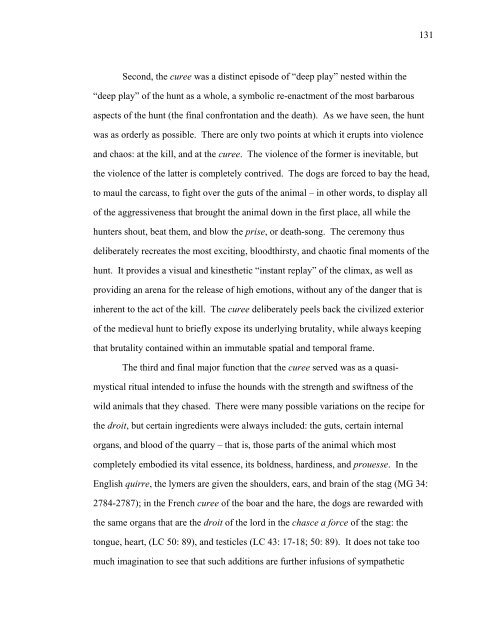Chapter 4 The Gift.pdf - eCommons@Cornell
Chapter 4 The Gift.pdf - eCommons@Cornell
Chapter 4 The Gift.pdf - eCommons@Cornell
You also want an ePaper? Increase the reach of your titles
YUMPU automatically turns print PDFs into web optimized ePapers that Google loves.
Second, the curee was a distinct episode of “deep play” nested within the<br />
“deep play” of the hunt as a whole, a symbolic re-enactment of the most barbarous<br />
aspects of the hunt (the final confrontation and the death). As we have seen, the hunt<br />
was as orderly as possible. <strong>The</strong>re are only two points at which it erupts into violence<br />
and chaos: at the kill, and at the curee. <strong>The</strong> violence of the former is inevitable, but<br />
the violence of the latter is completely contrived. <strong>The</strong> dogs are forced to bay the head,<br />
to maul the carcass, to fight over the guts of the animal – in other words, to display all<br />
of the aggressiveness that brought the animal down in the first place, all while the<br />
hunters shout, beat them, and blow the prise, or death-song. <strong>The</strong> ceremony thus<br />
deliberately recreates the most exciting, bloodthirsty, and chaotic final moments of the<br />
hunt. It provides a visual and kinesthetic “instant replay” of the climax, as well as<br />
providing an arena for the release of high emotions, without any of the danger that is<br />
inherent to the act of the kill. <strong>The</strong> curee deliberately peels back the civilized exterior<br />
of the medieval hunt to briefly expose its underlying brutality, while always keeping<br />
that brutality contained within an immutable spatial and temporal frame.<br />
<strong>The</strong> third and final major function that the curee served was as a quasi-<br />
mystical ritual intended to infuse the hounds with the strength and swiftness of the<br />
wild animals that they chased. <strong>The</strong>re were many possible variations on the recipe for<br />
the droit, but certain ingredients were always included: the guts, certain internal<br />
organs, and blood of the quarry – that is, those parts of the animal which most<br />
completely embodied its vital essence, its boldness, hardiness, and prouesse. In the<br />
English quirre, the lymers are given the shoulders, ears, and brain of the stag (MG 34:<br />
2784-2787); in the French curee of the boar and the hare, the dogs are rewarded with<br />
the same organs that are the droit of the lord in the chasce a force of the stag: the<br />
tongue, heart, (LC 50: 89), and testicles (LC 43: 17-18; 50: 89). It does not take too<br />
much imagination to see that such additions are further infusions of sympathetic<br />
131

















